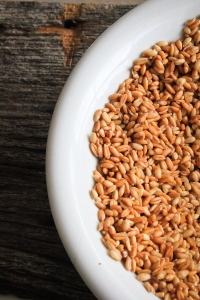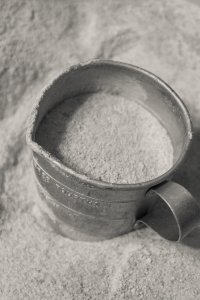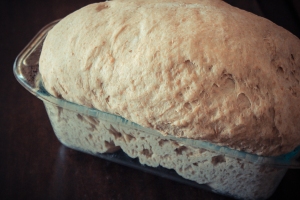 I’m sure you know by now that I love to bake.
I’m sure you know by now that I love to bake.
And I love to experiment. So sprouting grains for bread has been on my to-do list for a long time. I finally got around to it the other day.
How To Sprout Grains:
- Soak your grains in warm water for 12 hours or overnight. (You can choose to sprout as little or as many grains as you’d like. Just make sure that when you soak them, they are covered by several inches of water.)
- Drain and rinse the grains. Rinse them a couple of times a day. Do this for 2-3 days.
- The grains are done when there’s a small white root that appears on one end of the grain. Do not over sprout! You don’t want to let the sprout grow longer than that otherwise you can end up with bread that’s gooey and unappealing.
How to Make Sprouted Grain Flour:
- Once your grains have sprouted, transfer them to a mesh-lined dehydrator tray (or several depending on the size of your batch).
- Dry at 110˚ for ~12 hours or overnight until fully dry.
- Grind grains in a grain mill on the finest level and store in an airtight container in the freezer until needed.
What’s the point of sprouting your grains? Here’s where it gets cool.
Sprouting seeds and grains changes them from starches into plants. What??? You get so many more benefits from the sprouted grain than you do by eating it un-sprouted. During sprouting, enzymes transform the starch of the endosperm into simpler molecules that are easier to digest. Not only are they easier to digest but the amount of vitamins and minerals are increased during the sprouting process.
Easier to digest and better for me? And I still get to eat my beloved breads? Sign me on!
There’s not really much work involved with sprouting grains but you do need to plan ahead. It takes a few days to get the grains sprouted and then another day to dehydrate them again to be able to grind into a flour. There are actually two methods to using sprouted grains.
-The dry method: Sprout the grains, dry them to lock them into the new nutritional state, and then grind them into flour.
-The wet method: Sprout the grains, purée the grains into a wet mush, and store in the fridge or freezer until ready to use in bread recipes. If you store it in the fridge, you should use it within 1-2 days.
So far, I’ve been using the dry method. Although drying it is an extra step, I like being able to use the flour just like regular flour in my recipes. At some point, I’m sure I’ll test using the wet purée for a bread but just haven’t yet. If you’ve tried both, which one do you prefer?
I’ve made several different things with my sprouted flour but so far my favorite is with the Best Whole Wheat Bread. I cut the butter down to 1/4 cup because I’d read that sprouted grains needed less fat to “process” them. I’m not sure on the science part of that but the bread turned out great so I’m running with it. One thing I was surprised to see was how quickly my bread rose. Here you can see a large loaf that grew quickly in just half the time as it normally takes this recipe to rise. Keep that in mind when you’re baking bread with sprouted flour!
I do soak and sprout my grains. Thank you Emily for Sharing your recipe. I look forward to trying it. Come and see what I do at Sharinglifesabundance.wordpress.com
Thanks for sharing your helpful recommendations.